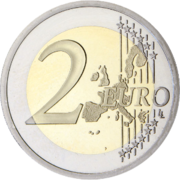| Value | 2 euro |
|---|---|
| Mass | 8.5 g |
| Diameter | 25.75 mm |
| Thickness | 2.20 mm |
| Edge | Edge lettering, fine milled. Exact design varies, see below. |
| Composition | Outer segment: copper-nickel. Inner segment: three layers: nickel-brass, nickel, nickel-brass. |
| Years of minting | 1999–present |
| Obverse | |
| Design | Numerous variations, see below. |
| Designer | Various |
| Design date | Various |
| Reverse | |
 | |
| Design | Map of Europe with the denomination shown in Latin characters |
| Designer | Luc Luycx |
| Design date | 2007 |
 | |
| Design | Map of the 15 EU countries of 1999 with the denomination shown in Latin characters |
| Designer | Luc Luycx |
| Design date | 1999 |
| Design discontinued | 2007 (still in circulation as of 2024[update]) |
The 2 euro coin (€2) is the highest-value euro coin and has been used since the introduction of the euro (in its cash form) in 2002.[2] The coin is made of two alloys: the inner part of nickel brass, the outer part of copper-nickel. All coins have a common reverse side and country-specific national sides. The coin has been used since 2002, with the present common side design dating from 2007.
The €2 coin is the euro coin subject to legal-tender[3] commemorative issues and hence there is a large number of national sides, including three issues of identical commemorative sides by all eurozone members.
- ^ Institutions and the members of the Eurozone
- ^ * "Andorran Euro Coins". Eurocoins.co.uk. Eurocoins.co.uk. 2003. Archived from the original on 16 August 2012. Retrieved 15 October 2011.
- "By UNMIK administration direction 1999/2". Unmikonline.org. 4 October 1999. Archived from the original on 7 June 2011. Retrieved 30 May 2010.
- "Monetary agreement between France (acting for the EC) and Monaco". 31 May 2002. Retrieved 30 May 2010.
- "Monetary agreement between Italy (acting for the EC) and San Marino". 27 July 2001. Retrieved 30 May 2010.
- "Monetary agreement between Italy (acting for the EC) and Vatican City". 25 October 2001. Retrieved 30 May 2010.
- "ECB: Map of euro area 1999 – 2011". ECB. ecb.int. 1 January 2011. Retrieved 27 October 2011.
- "Total population as of 1 January". Epp.eurostat.ec.europa.eu. 11 March 2011. Archived from the original on 20 July 2011. Retrieved 17 July 2011.
- ^ Other commemorative coins of various values are minted, but not for general circulation.